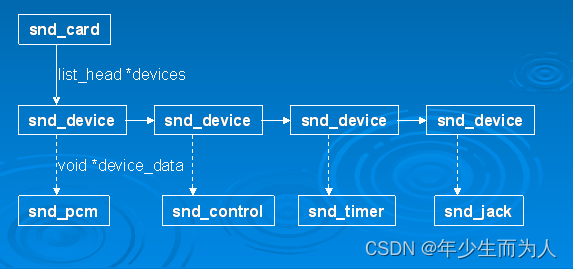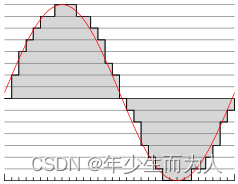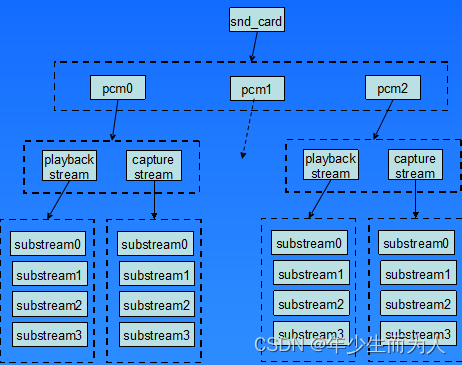ALSA 声卡与设备
一、ALSA Sound 初始化
1、alsa_sound_init() 入口函数
在我们创建声卡前,ALSA Sound 会先有相应的初始化,即 sound.c 的入口函数,位于 sound/core/sound.c,主要是用于申请一个字符设备的主设备号(116),后面的 pcm、control 等逻辑设备都是这个主设备号下的次设备。
/*
* INIT PART
*/
static int __init alsa_sound_init(void)
{
snd_major = major;
snd_ecards_limit = cards_limit;
//获取字符设备主设备号,即声卡的主设备号,其他声卡设备都是其下的次设备号
if (register_chrdev(major, "alsa", &snd_fops)) {
pr_err("ALSA core: unable to register native major device number %d\n", major);
return -EIO;
}
//创建 snd_proc_root 目录为 /proc/sound
if (snd_info_init() < 0) {
unregister_chrdev(major, "alsa");
return -ENOMEM;
}
#ifndef MODULE
pr_info("Advanced Linux Sound Architecture Driver Initialized.\n");
#endif
return 0;
}
其中 struct snd_fops 定义如下,所有次设备共用一个 open 接口,
static const struct file_operations snd_fops =
{
.owner = THIS_MODULE,
.open = snd_open,
.llseek = noop_llseek,
};
snd_open 函数定义如下:
static int snd_open(struct inode *inode, struct file *file)
{
//获取声卡下对应的次设备
unsigned int minor = iminor(inode);
struct snd_minor *mptr = NULL;
const struct file_operations *new_fops;
int err = 0;
if (minor >= ARRAY_SIZE(snd_minors))
return -ENODEV;
mutex_lock(&sound_mutex);
//获取到具体的声卡设备,即次设备比如 control、pcm 设备等
mptr = snd_minors[minor];
if (mptr == NULL) {
mptr = autoload_device(minor);
if (!mptr) {
mutex_unlock(&sound_mutex);
return -ENODEV;
}
}
//获取次设备的 f_ops 文件结构体
new_fops = fops_get(mptr->f_ops);
mutex_unlock(&sound_mutex);
if (!new_fops)
return -ENODEV;
//用次设备的 file_operations 替换
replace_fops(file, new_fops);
//执行该次设备的文件 open 函数
if (file->f_op->open)
err = file->f_op->open(inode, file);
return err;
}
如上述注释所述,在 snd_open 函数中利用次设备号根据全局数组 snd_minors 找到相应的次设备 file_operations 并替换,最后调用相应次设备的 open 函数。(备注:很多设备框架都是使用这种做法)
snd_minors 是定义在 sound.c 中的全局变量,表示主设备号下的次设备比如 control、pcm 设备等,定义如下:
struct snd_minor {
int type; /* SNDRV_DEVICE_TYPE_XXX */
int card; /* card number */
int device; /* device number */
const struct file_operations *f_ops; /* file operations */
void *private_data; /* private data for f_ops->open */
struct device *dev; /* device for sysfs */
struct snd_card *card_ptr; /* assigned card instance */
};
static struct snd_minor *snd_minors[SNDRV_OS_MINORS];
其中包含的设备类型如下,位于 include/sound/minors.h
enum {
SNDRV_DEVICE_TYPE_CONTROL,
SNDRV_DEVICE_TYPE_SEQUENCER,
SNDRV_DEVICE_TYPE_TIMER,
SNDRV_DEVICE_TYPE_HWDEP,
SNDRV_DEVICE_TYPE_RAWMIDI,
SNDRV_DEVICE_TYPE_PCM_PLAYBACK,
SNDRV_DEVICE_TYPE_PCM_CAPTURE,
SNDRV_DEVICE_TYPE_COMPRESS,
};
2、init_soundcore() 入口函数
该入口函数是 sound_core.c 的入口函数,主要用于创建 sound_class,如下
static char *sound_devnode(struct device *dev, umode_t *mode)
{
if (MAJOR(dev->devt) == SOUND_MAJOR)
return NULL;
return kasprintf(GFP_KERNEL, "snd/%s", dev_name(dev));
}
static int __init init_soundcore(void)
{
int rc;
rc = init_oss_soundcore();
if (rc)
return rc;
//创建全局 sound_class
sound_class = class_create(THIS_MODULE, "sound");
if (IS_ERR(sound_class)) {
cleanup_oss_soundcore();
return PTR_ERR(sound_class);
}
sound_class->devnode = sound_devnode;
return 0;
}
subsys_initcall(init_soundcore);
二、声卡结构体与创建、注册
1、struct snd_card
结构体 snd_card 是整个 ALSA 音频驱动最顶层的一个结构体,整个声卡的软件逻辑结构开始于该结构,几乎所有与声音相关的逻辑设备都是在 snd_card 的管理之下,声卡驱动的第一个动作就是创建一个 snd_card 结构体,其定位于 include/sound/core.h,如下:
/* main structure for soundcard */
struct snd_card {
int number; /* number of soundcard (index to
snd_cards) */
char id[16]; /* id string of this card */
char driver[16]; /* driver name */
char shortname[32]; /* short name of this soundcard */
char longname[80]; /* name of this soundcard */ //会在具体驱动中设置,主要反映在/proc/asound/cards中
char irq_descr[32]; /* Interrupt description */
char mixername[80]; /* mixer name */
char components[128]; /* card components delimited with
space */
struct module *module; /* top-level module */
void *private_data; /* private data for soundcard */ //声卡的私有数据,可以在创建声卡时通过参数指定数据的大小
void (*private_free) (struct snd_card *card); /* callback for freeing of
private data */
struct list_head devices; /* devices */ //记录该声卡下所有逻辑设备的链表
struct device ctl_dev; /* control device */
unsigned int last_numid; /* last used numeric ID */
struct rw_semaphore controls_rwsem; /* controls list lock */
rwlock_t ctl_files_rwlock; /* ctl_files list lock */
int controls_count; /* count of all controls */
int user_ctl_count; /* count of all user controls */
struct list_head controls; /* all controls for this card */ //记录该声卡下所有控制单元的链表
struct list_head ctl_files; /* active control files */ //用于管理该card下的active的control设备
struct snd_info_entry *proc_root; /* root for soundcard specific files */
struct snd_info_entry *proc_id; /* the card id */
struct proc_dir_entry *proc_root_link; /* number link to real id */
struct list_head files_list; /* all files associated to this card */
struct snd_shutdown_f_ops *s_f_ops; /* file operations in the shutdown
state */
spinlock_t files_lock; /* lock the files for this card */
int shutdown; /* this card is going down */
struct completion *release_completion;
struct device *dev; /* device assigned to this card */ //和card相关的设备
struct device card_dev; /* cardX object for sysfs */ //card用于在sys中显示,用于代表该card
const struct attribute_group *dev_groups[4]; /* assigned sysfs attr */
bool registered; /* card_dev is registered? */
wait_queue_head_t remove_sleep;
#ifdef CONFIG_PM
unsigned int power_state; /* power state */
wait_queue_head_t power_sleep;
#endif
#if IS_ENABLED(CONFIG_SND_MIXER_OSS)
struct snd_mixer_oss *mixer_oss;
int mixer_oss_change_count;
#endif
};
其中 snd_card 的 driver 字段保存着芯片的 ID 字符串,用户空间的 alsa-lib 会使用到该字符串,所以必须保证该 ID 的唯一性,shortname 字段更多地用于打印信息,longname 字段则会出现在 /proc/asound/cards 中。
2、声卡创建流程
1、创建 snd_card 实例
/**
* snd_card_new - create and initialize a soundcard structure
* @parent: the parent device object
* @idx: card index (address) [0 ... (SNDRV_CARDS-1)]
* @xid: card identification (ASCII string)
* @module: top level module for locking
* @extra_size: allocate this extra size after the main soundcard structure
* @card_ret: the pointer to store the created card instance
* * Creates and initializes a soundcard structure.
* * The function allocates snd_card instance via kzalloc with the given
* space for the driver to use freely. The allocated struct is stored
* in the given card_ret pointer.
* * Return: Zero if successful or a negative error code.
*/
int snd_card_new(struct device *parent, int idx, const char *xid,
struct module *module, int extra_size,
struct snd_card **card_ret);
通过如上描述的 snd_card_new() 函数可以创建一个声卡实例,参数 & 功能描述如上,api 主要 flow 如下,
snd_card_new
--> 根据 extra_size 参数大小用 kzalloc 分配一个 snd_card,如果 extra_size > 0 则将 snd_card->private_data 指向 extra_size addr;
--> 初始化 snd_card 结构体的必要字段,id、idx 及 card->card_dev;
--> snd_ctl_create() # 建立逻辑设备:Control
=> snd_device_new(SNDRV_DEV_CONTROL) # 填充 dev 字段,如 type,state,ops,dev_data=card,并将该 device insert 到 card->devices list 中。
--> snd_info_card_create(card) # 建立 proc 文件中的 info 节点:通常就是 /proc/asound/card0
声卡的专用数据主要用于存放一些资源信息,例如中断资源、io资源、dma资源等,根据 extra_size 参数分有两种方式创建 snd_card,
- 1)内部分配,通过 snd_card_create 函数创建 private_data
// 创建 struct my_chip_priv 结构体
struct my_chip_priv {
...
};
// 创建 snd_card
snd_card_new(dev, idx, xid, THIS_MODULE, sizeof(my_chip_priv), &card);
//从 snd_card->private_data 取数据
struct my_chip_priv *my_chip = card->private_data;
- 2)外部分配,自己创建 priv_buf,并将 snd_card->private_data 指向它
// 创建 struct my_chip_priv 结构体(内部成员包含 snd_card)
struct my_chip_priv {
struct snd_card *card;
...
};
struct snd_card *card;
struct my_chip_priv *my_chip;
// 手动创建
my_chip = kzalloc(sizeof(*chip), GFP_KERNEL);
// 创建 snd_card
snd_card_new(dev, idx, xid, THIS_MODULE, 0, &card);
// 专用数据记录snd_card实例
my_chip->card = card;
2、设置 snd_card 的 Driver ID 和 Name
strcpy(card->driver, "My Chip");
strcpy(card->shortname, "My Own Chip 123");
sprintf(card->longname, "%s at 0x%lx irq %i", card->shortname, chip->ioport, chip->irq);
snd_card 的 driver 字段保存着芯片的 ID 字符串,user空间的 alsa-lib 会使用到该字符串,所以必须要保证该 ID 的唯一性。shortname 字段更多地用于打印信息,longname 字段则会出现在 /proc/asound/cards 中。
3、创建声卡的功能部件(逻辑设备)
还记得 snd_card 结构体中的 devices 字段吗?在注册声卡的时候会对该 devices 链表中的所有逻辑设备都进行注册,故在注册声卡前需要调用 snd_device_new() 来生成一个 snd_device 实例,并将该实例链接到 snd_card 的 devices 链表中。
通常,alsa-driver的已经提供了一些常用的部件的创建函数,而不必直接调用snd_device_new(),常见的如下:
PCM ---- snd_pcm_new()
RAWMIDI -- snd_rawmidi_new()
CONTROL -- snd_ctl_create()
TIMER -- snd_timer_new()
INFO -- snd_card_proc_new()
JACK -- snd_jack_new()
API 详细见下方逻辑设备描述~
4、注册声卡
/**
* snd_card_register - register the soundcard
* @card: soundcard structure
*
* This function registers all the devices assigned to the soundcard.
* Until calling this, the ALSA control interface is blocked from the
* external accesses. Thus, you should call this function at the end
* of the initialization of the card.
*
* Return: Zero otherwise a negative error code if the registration failed.
*/
int snd_card_register(struct snd_card *card);
注册声卡时需要 Call snd_card_register() 函数,如注释所述,该 api 内部会 register 所有 devices,关于该 API 的主要 Flow 如下:
snd_card_register
--> device_add(&card->card_dev) 创建 /sys/devices 下的设备;
--> snd_device_register_all(card) 通过 snd_card 的 devices 链表,遍历所有的 snd_device,并且调用 snd_device 的 ops->dev_register() 来实现格子设备的注册;
经过上述的创建声卡步骤后,声卡的逻辑结构则如下图所示:

3、声卡创建过程使用举例
三、声卡之 Pcm 设备
1、Pcm 设备简介
PCM 是英文 Pulse-code modulation 的缩写,中文译名是脉冲编码调制。PCM就是要把声音从模拟转换成数字信号的一种技术,简单的来说就是利用一个固定的频率对模拟信号进行采样,采样后的信号的幅值按一定的采样精度进行量化,量化后的数值被连续地输出、传输、处理或记录到存储介质中。

PCM 信号的两个重要指标是采样频率和量化精度,目前,CD音频的采样频率通常为 44100 Hz,量化精度是 16bit。通常,播放音乐时,用程序从存储介质中读取音频数据(MP3、WMA、AAC…),经过解码后,最终送到音频驱动程序中的就是PCM数据,反过来,在录音时,音频驱动不停地把采样所得的PCM数据送回给应用程序,由应用程序完成压缩、存储等任务。所以,音频驱动的两大核心任务就是:
playback如何把用户空间的应用程序发过来的PCM数据,转化为人耳可以辨别的模拟音频;capture把mic拾取到得模拟信号,经过采样、量化,转换为PCM信号送回给用户空间的应用程序。
2、ALSA Driver 的 Pcm 中间层
ALSA 已经实现了 Pcm 中间层,我们的驱动都是调用 pcm 相关 api,基本上只需要实现底层的需要访问硬件的函数即可。
<sound/pcm.h>提供访问 PCM 中间层代码的 API<sound/pcm_params.h>提供访问一些与 hw_param 相关的函数
前面提到过声卡中挂载着 Pcm Device,Pcm 设备用 snd_pcm 结构体描述,一个 Pcm 实例下面有一个 playback & capture stream,针对 alsa asoc 都是 playback & capture 下各自只有一个 substream.

3、Pcm 设备创建
/**
* snd_pcm_new - create a new PCM instance
* @card: the card instance
* @id: the id string
* @device: the device index (zero based)
* @playback_count: the number of substreams for playback
* @capture_count: the number of substreams for capture
* @rpcm: the pointer to store the new pcm instance
*
* Creates a new PCM instance.
*
* The pcm operators have to be set afterwards to the new instance
* via snd_pcm_set_ops().
*
* Return: Zero if successful, or a negative error code on failure.
*/
int snd_pcm_new(struct snd_card *card, const char *id, int device,
int playback_count, int capture_count, struct snd_pcm **rpcm);
/**
* snd_pcm_new_internal - create a new internal PCM instance
* @card: the card instance
* @id: the id string
* @device: the device index (zero based - shared with normal PCMs)
* @playback_count: the number of substreams for playback
* @capture_count: the number of substreams for capture
* @rpcm: the pointer to store the new pcm instance
*
* Creates a new internal PCM instance with no userspace device or procfs
* entries. This is used by ASoC Back End PCMs in order to create a PCM that
* will only be used internally by kernel drivers. i.e. it cannot be opened
* by userspace. It provides existing ASoC components drivers with a substream
* and access to any private data.
*
* The pcm operators have to be set afterwards to the new instance
* via snd_pcm_set_ops().
*
* Return: Zero if successful, or a negative error code on failure.
*/
int snd_pcm_new_internal(struct snd_card *card, const char *id, int device,
int playback_count, int capture_count,
struct snd_pcm **rpcm)
通过 snd_pcm_new() / snd_pcm_new_internal() 创建 Pcm 设备,如注释所述,internal api 则不会创建 dev 供外部访问,其主要 Flow 如下:
snd_pcm_new() / snd_pcm_new_internal() # 创建 Pcm 设备(是否可供外部访问)
--> call _snd_pcm_new(internal = false/true)
=> 分配 snd_pcm,填充 snd_pcm 字段,如 card,device,internal
=> call snd_pcm_new_stream(SNDRV_PCM_STREAM_PLAYBACK, playback_count)
==> 填充 pcm_streams[PLAYBACK]字段,如stream,substream_count
==> dev_set_name( pcmC0Dxp )
==>d for(substream_count) 分配 substream,填充 substream 字段,如 streams,number,stream等,并将所有的 substream 填充到 snd_pcm->snd_pcm_substream->substream 中。
=> snd_pcm_new_stream(SNDRV_PCM_STREAM_CAPTURE) # 同 playback,略
=> snd_device_new(SNDRV_DEV_PCM)
==> 填充 dev 字段,如type,state,ops,dev_data=snd_pcm,并将该 device insert 到 card->device list 中。【其中根据 internal 差异会选择不同的 snd_dev_ops/internal_ops】
在注册声卡的时候会注册挂在该声卡下所有的 Device,对于 Pcm Device 则会 call 如下函数:
snd_pcm_dev_register()
--> call snd_pcm_add(pcm) # 将 pcm 插入到全局链表 snd_pcm_devices
--> call snd_register_device(SNDRV_DEVICE_TYPE_PCM_PLAYBACK/CAPTURE)
=> 定义 & 分配 snd_minor 并填充字段,如 type,dev,f_ops = snd_pcm_f_ops[0:playback, 1:capture],private_data=snd_pcm(在 open 时会取 private_data)
=> 创建 /dev/snd/pcmC0Dxp & pcmC0Dxc 字符设备,并根据 minor 次设备号保存在 snd_minor[minor] 中(如前面所述,在 snd_open 时会根据 minor 拿到这里保存的 snd_minor[minor],并替换 f_ops=snd_pcm_f_ops)
至此,Pcm Device 则已经创建。
四、声卡之 Control 设备
1、Control 设备简介
Control 接口主要让用户空间的应用程序(alsa-lib/tinyalsa)可以访问和控制音频 codec 芯片中的多路开关,滑动控件等。常见的 control 控件有 Mixer,Mux,Demux 等。
<sound/control.h> 定义了所有的 Control API. 如果你要为你的codec实现自己的controls,请在代码中包含该头文件。
2、Control 设备的建立
Control设备和PCM设备一样,都属于声卡下的逻辑设备。用户空间的应用程序通过alsa-lib访问该Control设备,读取或控制control的控制状态,从而达到控制音频Codec进行各种Mixer等控制操作。
Control设备的创建过程大体上和PCM设备的创建过程相同。对于创建 Pcm 设备只需要在驱动初始化时主动调用 snd_pcm_new() 函数创建,而 control 设备则用 snd_ctl_create() 创建。不过由于 snd_card_create() 函数中已经会调用 snd_ctl_create() 函数创建 control 设备节点,故我们无需显示地创建 control 设备,只要建立声卡,control 设备则被自动地创建。
和 Pcm Device 一样,在注册声卡的时候会注册挂在该声卡下所有的 Device,对于 Control Device 则会 call 如下函数:
snd_ctl_dev_register()
--> call snd_register_devices(SNDRV_DEVICE_TYPE_CONTROL)
=> 定义 & 分配 snd_minor 并填充字段,如 type,device,f_ops=snd_ctl_f_ops,private_data=card(在 open 时会取 private_data)
=> 创建 /dev/snd/ControlCx 字符设备,并根据 minor 次设备号保存在 snd_minor[minor] 中(如前面所述,在 snd_open 时会根据 minor 拿到这里保存的 snd_minor[minor],并替换 f_ops=snd_ctl_f_ops)
3、Controls 的创建
当用户空间需要控制某个控件,如 mixer 等,我们必须要将该控件定位为 control,使得用户空间可以访问控制,Controls 的创建步骤如下:
(1)定义一个 snd_kcontrol_new 实例;
(2)通过 snd_ctl_new1() 分配 snd_kcontrol 对象,并将 snd_kcontrol_new 对象相应的值复制到该实例中;
(3)通过 snd_ctl_add(card, kcontrol) 将 snd_kcontrol 添加到 card->controls list 中。
(1)snd_kcontrol_new 的定义
要自定义一个Control,我们首先要定义3各回调函数:info,get 和 put。然后,定义一个 snd_kcontrol_new 结构:
static struct snd_kcontrol_new my_control __devinitdata = {
.iface = SNDRV_CTL_ELEM_IFACE_MIXER,
.name = "PCM Playback Switch",
.index = 0,
.access = SNDRV_CTL_ELEM_ACCESS_READWRITE,
.private_value = 0xffff,
.info = my_control_info,
.get = my_control_get,
.put = my_control_put
};
iface 字段指出了 control 的类型,alsa定义了几种类型(SNDDRV_CTL_ELEM_IFACE_XXX),常用的类型是 MIXER,当然也可以定义属于全局的 CARD 类型,也可以定义属于某类设备的类型,例如 HWDEP,PCMRAWMIDI,TIMER 等,这时需要在 device 和 subdevice 字段中指出卡的设备逻辑编号。
name 字段是该 control 的名字,从ALSA 0.9.x开始,control 的名字是变得比较重要,因为 control 的作用是按名字来归类的。ALSA 已经预定义了一些 control 的名字,我们在后面的章节中会详细讨论。
index 字段用于保存该 control 的在该卡中的编号。如果声卡中有不止一个 codec,每个 codec 中有相同名字的 control,这时我们可以通过index 来区分这些 controls。当 index 为 0 时,则可以忽略这种区分策略。
access 字段包含了该control的访问类型。每一个 bit 代表一种访问类型,这些访问类型可以多个“或”运算组合在一起。
private_value 字段包含了一个任意的长整数类型值。该值可以通过info,get,put 这几个回调函数访问。你可以自己决定如何使用该字段。例如可以把它拆分成多个位域,又或者是一个指针,指向某一个数据结构。
tlv字段为该control提供元数据。
Control的名字
control 的名字需要遵循一些标准,通常可以分成 3 部分来定义 control 的名字:源–方向–功能。
- 源:可以理解为该control的输入端,alsa 已经预定义了一些常用的源,例如:Master,PCM,CD,Line等等.。
- 方向:代表该control的数据流向,例如:Playback,Capture,Bypass,Bypass Capture 等等,也可以不定义方向,这时表示该Control 是双向的( playback 和 capture )。
- 功能:根据 control 的功能,可以是以下字符串:Switch,Volume,Route 等等。
也有一些命名上的特例:
-
全局的 capture 和 playback“Capture Source”,“Capture Volume”,“Capture Switch”,它们用于全局的 capture source,switch 和 volume。同理,“Playback Volume”,“Playback Switch”,它们用于全局的输出 switch 和 volume。 -
Tone-controles音调控制的开关和音量命名为:Tone Control - XXX,例如。“Tone Control - Switch”,“Tone Control - Bass”,“Tone Control - Center”. -
3D controls3D控件的命名规则:“3D Control - Switch”,“3D Control - Center”,“3D Control - Space”. -
Mic boost麦克风音量加强控件命名为:“Mic Boost” 或 “Mic Boost(6dB)”.
访问标志(ACCESS Flags)
Access字段是一个 bitmask,它保存了该 control 的访问类型。默认的访问类型是:SNDDRV_CTL_ELEM_ACCESS_READWRITE,表明该 control 支持读和写操作。如果 access 字段没有定义(.access==0),此时也认为是 READWRITE 类型。
如果是一个只读 control,access 应该设置为:SNDDRV_CTL_ELEM_ACCESS_READ,这时,我们不必定义 put 回调函数。类似地,如果是只写 control,access 应该设置为:SNDDRV_CTL_ELEM_ACCESS_WRITE,这时,我们不必定义 get 回调函数。
如果control的值会频繁地改变(例如:电平表),我们可以使用VOLATILE 类型,这意味着该 control 会在没有通知的情况下改变,应用程序应该定时地查询该control的值。
回调函数
info 回调函数用于获取control的详细信息。它的主要工作就是填充通过参数传入的 snd_ctl_elem_info 对象,以下例子是一个具有单个元素的 boolean 型 control 的 info 回调:
static int snd_myctl_mono_info(struct snd_kcontrol *kcontrol,
struct snd_ctl_elem_info *uinfo)
{
uinfo->type = SNDRV_CTL_ELEM_TYPE_BOOLEAN;
uinfo->count = 1;
uinfo->value.integer.min = 0;
uinfo->value.integer.max = 1;
return 0;
}
type 字段指出该 control 的值类型,值类型可以是 BOOLEAN,INTEGER,ENUMERATED,BYTES,IEC958 和 INTEGER64 之一。
count 字段指出了该 control 中包含有多少个元素单元,比如,立体声的音量 control 左右两个声道的音量值,它的 count 字段等于2。
value 字段是一个联合体(union),value 的内容和 control 的类型有关。其中,boolean 和 integer 类型是相同的。
ENUMERATED 类型有些特殊。它的 value 需要设定一个字符串和字符串的索引,请看以下例子:
static int snd_myctl_enum_info(struct snd_kcontrol *kcontrol,
struct snd_ctl_elem_info *uinfo)
{
static char *texts[4] = {
"First", "Second", "Third", "Fourth"
};
uinfo->type = SNDRV_CTL_ELEM_TYPE_ENUMERATED;
uinfo->count = 1;
uinfo->value.enumerated.items = 4;
if (uinfo->value.enumerated.item > 3)
uinfo->value.enumerated.item = 3;
strcpy(uinfo->value.enumerated.name,
texts[uinfo->value.enumerated.item]);
return 0;
}
alsa 已经为我们实现了一些通用的 info 回调函数,例如:snd_ctl_boolean_mono_info(),snd_ctl_boolean_stereo_info() 等等。
get 回调函数用于读取 control 的当前值,并返回给用户空间的应用程序。
static int snd_myctl_get(struct snd_kcontrol *kcontrol,
struct snd_ctl_elem_value *ucontrol)
{
struct mychip *chip = snd_kcontrol_chip(kcontrol);
ucontrol->value.integer.value[0] = get_some_value(chip);
return 0;
}
value 字段的赋值依赖于 control 的类型(如同 info 回调)。很多声卡的驱动利用它存储硬件寄存器的地址、bit-shift 和 bit-mask,这时,private_value 字段可以按以下例子进行设置:
private_value = reg | (shift << 16) | (mask << 24);
然后,get 回调函数可以这样实现:
static int snd_sbmixer_get_single(struct snd_kcontrol *kcontrol,
struct snd_ctl_elem_value *ucontrol)
{
int reg = kcontrol->private_value & 0xff;
int shift = (kcontrol->private_value >> 16) & 0xff;
int mask = (kcontrol->private_value >> 24) & 0xff;
....
//根据以上的值读取相应寄存器的值并填入value中
}
如果 control 的 count 字段大于1,表示 control 有多个元素单元,get回调函数也应该为 value 填充多个数值。
put 回调函数用于把应用程序的控制值设置到 control 中。
static int snd_myctl_put(struct snd_kcontrol *kcontrol,
struct snd_ctl_elem_value *ucontrol)
{
struct mychip *chip = snd_kcontrol_chip(kcontrol);
int changed = 0;
if (chip->current_value !=
ucontrol->value.integer.value[0]) {
change_current_value(chip,
ucontrol->value.integer.value[0]);
changed = 1;
}
return changed;
}
如上述例子所示,当 control 的值被改变时,put 回调必须要返回1,如果值没有被改变,则返回0。如果发生了错误,则返回一个负数的错误号。
和 get 回调一样,当 control 的 count 大于1时,put 回调也要处理多个 control 中的元素值。
(2)创建 Controls
当把以上讨论的内容都准备好了以后,我们就可以创建我们自己的control 了。alsa-driver 为我们提供了两个用于创建 control 的API:
snd_ctl_new1()
snd_ctl_add()
我们可以用以下最简单的方式创建 control:
err = snd_ctl_add(card, snd_ctl_new1(&my_control, chip));
if (err < 0)
return err;
在这里,my_control 是一个之前定义好的 snd_kcontrol_new 对象,chip 对象将会被赋值在 kcontrol->private_data 字段,该字段可以在回调函数中访问。
snd_ctl_new1() 会分配一个新的 snd_kcontrol 实例,并把 my_control中相应的值复制到该实例中,所以,在定义 my_control 时,通常我们可以加上 __devinitdata 前缀。snd_ctl_add 则把该 control 绑定到声卡对象 card 当中。
snd_ctl_new1(snd_kcontrol_new)
--> 定义 snd_kcontrol,call snd_ctl_new(&snd_control)
=> 根据 count 给 snd_kcontrol 分配空间,并填充 kcontrol 参数,如 vd[idx],access,count 等
--> 将 snd_kcontrol_new 中相应的值复制到 snd_control.
snd_ctl_add(card, snd_kcontrol)
--> call __snd_ctl_add(card, snd_kcontrol)
=> 根据 kcontrol->id find card->controls 是否已经有添加,对于新的 snd_kcontrol 则添加到 card->controls list 中,更新 card->controls_count 等参数.
参考链接:
https://www.cnblogs.com/xinghuo123/category/1786302.html?page=2